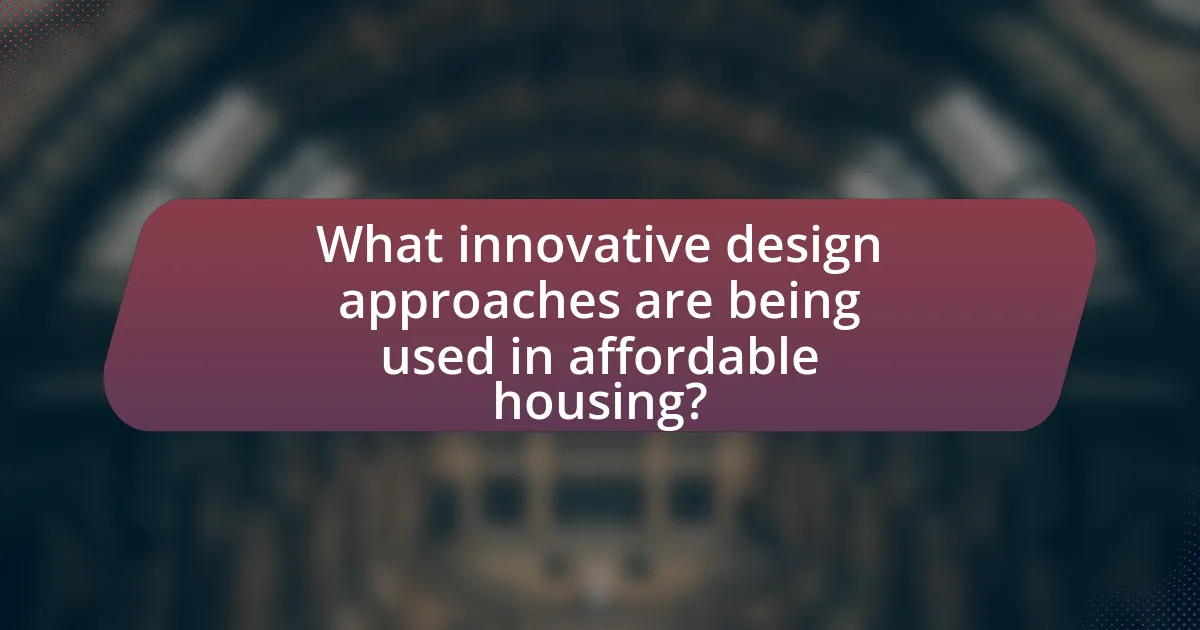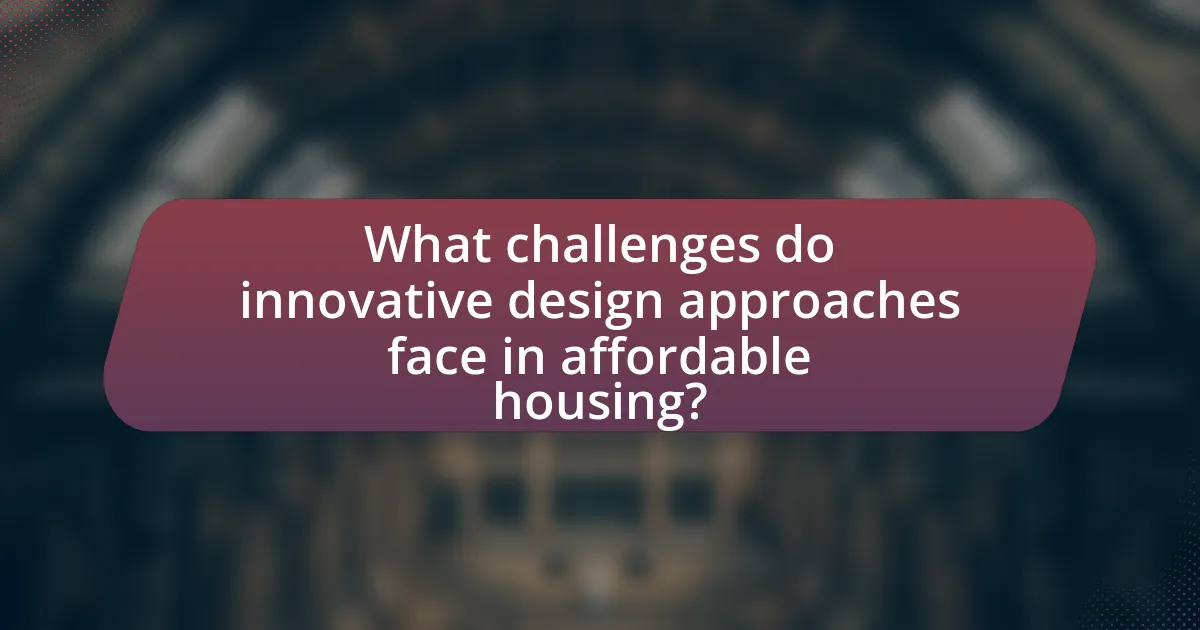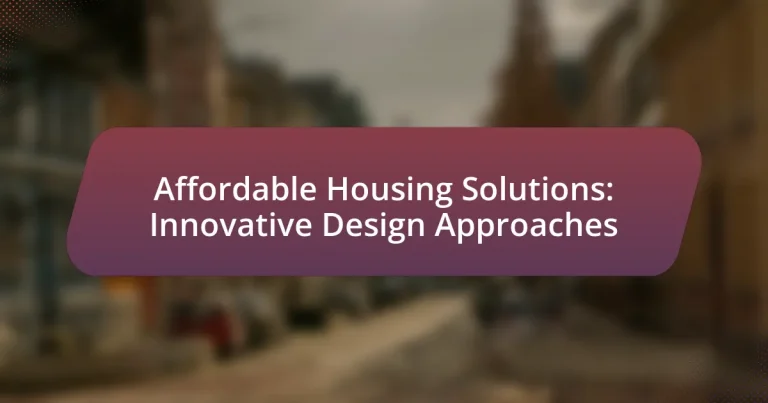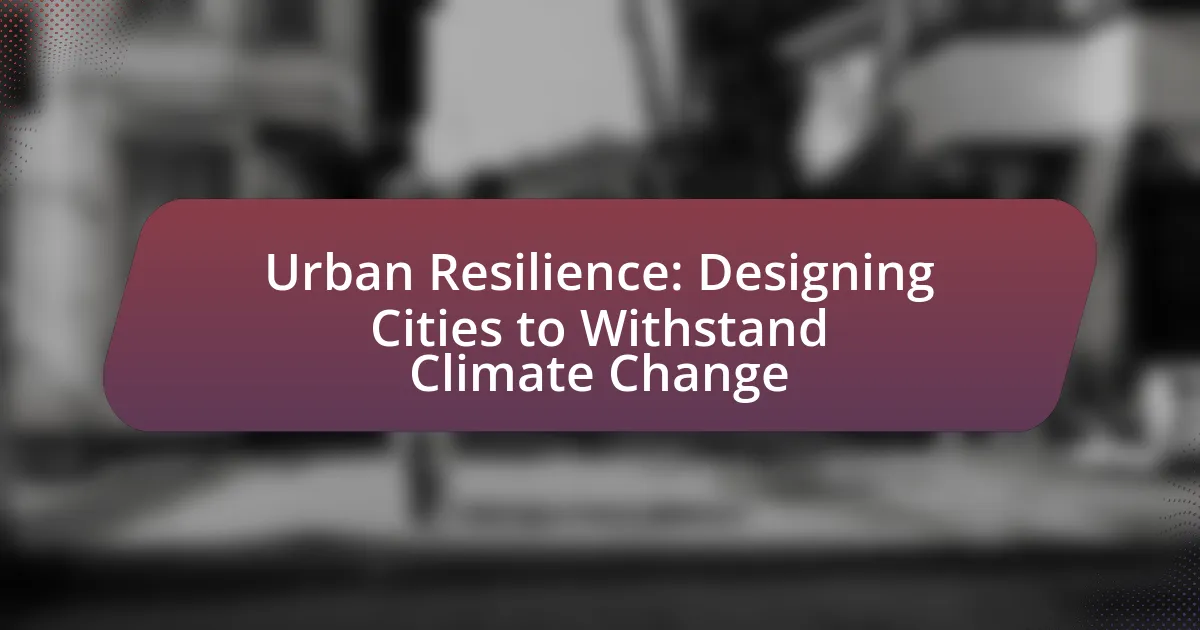Affordable housing solutions encompass various strategies aimed at providing accessible housing for low- and moderate-income individuals and families. This article explores innovative design approaches, such as modular construction and sustainable materials, that enhance affordability by reducing costs and construction time. It highlights the importance of community engagement and the principles of sustainability, adaptability, and user-centered design in creating effective housing solutions. Additionally, the article addresses the challenges posed by regulatory barriers and funding limitations, while emphasizing the social and economic impacts of affordable housing on communities.

What are Affordable Housing Solutions?
Affordable housing solutions are strategies and initiatives designed to provide housing that is affordable to low- and moderate-income individuals and families. These solutions can include a variety of approaches such as the development of subsidized housing, the implementation of inclusionary zoning policies, and the use of innovative construction techniques like modular building, which can reduce costs and time. For instance, according to the National Low Income Housing Coalition, there is a significant shortage of affordable rental homes, with only 37 affordable and available rental homes for every 100 extremely low-income renter households in the United States. This statistic underscores the urgent need for effective affordable housing solutions to address the housing crisis.
How do innovative design approaches contribute to affordable housing?
Innovative design approaches significantly contribute to affordable housing by optimizing space, reducing construction costs, and enhancing sustainability. For instance, modular construction techniques allow for faster assembly and lower labor costs, which can decrease overall housing expenses. Additionally, the use of sustainable materials and energy-efficient designs can lower utility costs for residents, making housing more affordable in the long term. Research from the National Association of Home Builders indicates that innovative building methods can reduce construction time by up to 50%, directly impacting affordability. Furthermore, designs that incorporate community spaces and multi-functional areas can maximize land use, providing more housing units within the same footprint, thus addressing the housing shortage effectively.
What are the key principles of innovative design in housing?
The key principles of innovative design in housing include sustainability, adaptability, community integration, and user-centered design. Sustainability focuses on minimizing environmental impact through energy-efficient materials and renewable energy sources, which is essential as buildings account for a significant portion of global carbon emissions. Adaptability allows housing to meet changing needs over time, ensuring longevity and relevance in various contexts. Community integration emphasizes creating spaces that foster social interaction and connectivity, enhancing the quality of life for residents. User-centered design prioritizes the needs and preferences of occupants, leading to more functional and satisfying living environments. These principles collectively contribute to creating affordable, efficient, and livable housing solutions.
How do these principles address affordability?
These principles address affordability by promoting cost-effective design strategies that reduce construction and operational expenses. For instance, utilizing modular construction techniques can significantly lower labor costs and construction time, making housing more accessible to low-income families. Additionally, principles such as sustainable materials and energy-efficient systems decrease long-term utility costs, further enhancing affordability. Studies indicate that homes built with these innovative approaches can reduce overall housing costs by up to 20%, thereby directly impacting affordability for residents.
Why is affordable housing important in today’s society?
Affordable housing is crucial in today’s society because it ensures that individuals and families can secure stable living conditions without financial strain. Access to affordable housing directly impacts economic stability, as it allows residents to allocate resources toward education, healthcare, and other essential needs. According to the National Low Income Housing Coalition, in 2021, a minimum-wage worker would need to work 97 hours per week to afford a modest two-bedroom rental home at fair market rent, highlighting the urgent need for affordable housing solutions. This lack of affordable options contributes to homelessness and housing insecurity, which further exacerbates social and economic disparities.
What social impacts arise from a lack of affordable housing?
A lack of affordable housing leads to increased homelessness and housing instability, which significantly impacts community cohesion and individual well-being. When individuals cannot secure stable housing, they often face heightened stress, mental health issues, and reduced access to essential services such as healthcare and education. According to the National Alliance to End Homelessness, in 2020, over 580,000 people experienced homelessness on a single night in the United States, illustrating the direct correlation between housing affordability and social stability. Furthermore, communities with high rates of homelessness often experience increased crime rates and economic decline, as the lack of stable housing can hinder workforce participation and local business growth.
How does affordable housing affect economic stability?
Affordable housing positively affects economic stability by providing low-income families with secure living conditions, which in turn fosters job stability and local economic growth. When families have access to affordable housing, they can allocate more of their income towards essential goods and services rather than excessive rent, leading to increased consumer spending in the community. Research from the National Low Income Housing Coalition indicates that for every $1 invested in affordable housing, there is a return of $1.50 to $2.00 in economic activity, demonstrating a clear link between affordable housing and enhanced economic stability.

What innovative design approaches are being used in affordable housing?
Innovative design approaches in affordable housing include modular construction, sustainable materials, and community-centric designs. Modular construction allows for prefabricated units to be assembled on-site, significantly reducing labor costs and construction time. For instance, a study by the National Institute of Building Sciences found that modular homes can be built 30% faster than traditional homes. Sustainable materials, such as recycled steel and bamboo, not only lower costs but also minimize environmental impact, aligning with green building standards. Community-centric designs focus on creating shared spaces and amenities that foster social interaction, which has been shown to improve residents’ quality of life and reduce isolation. These approaches collectively address the need for cost-effective, efficient, and livable housing solutions.
How does modular construction enhance affordability?
Modular construction enhances affordability by significantly reducing labor costs and construction time. This method involves prefabricating building components in a factory setting, which streamlines the construction process and minimizes on-site labor expenses. According to a study by the National Institute of Standards and Technology, modular construction can reduce project timelines by up to 50%, leading to lower overall costs. Additionally, the controlled factory environment allows for better material management and waste reduction, further contributing to cost savings.
What are the benefits of modular construction in housing?
Modular construction in housing offers several benefits, including reduced construction time, cost efficiency, and improved quality control. By utilizing prefabricated modules, projects can be completed up to 50% faster than traditional building methods, as components are manufactured off-site and assembled on-site. This approach also leads to lower labor costs and minimized material waste, with studies indicating that modular construction can reduce overall project costs by 10-20%. Furthermore, the controlled factory environment enhances quality assurance, resulting in fewer defects and higher durability in the final product.
How does modular construction impact construction timelines and costs?
Modular construction significantly reduces construction timelines and costs by enabling off-site fabrication of building components. This method allows for simultaneous site preparation and module construction, which can shorten project timelines by up to 50% compared to traditional construction methods. Additionally, modular construction can lower costs by reducing labor expenses and minimizing material waste; studies indicate that modular projects can achieve cost savings of 10-20% due to these efficiencies.
What role does sustainable design play in affordable housing?
Sustainable design plays a crucial role in affordable housing by reducing construction and operational costs while enhancing environmental quality. This approach incorporates energy-efficient materials and technologies, which can lower utility bills for residents, making housing more affordable in the long term. For instance, buildings designed with passive solar heating can decrease energy consumption by up to 50%, as reported by the U.S. Department of Energy. Additionally, sustainable design often includes the use of recycled materials and efficient water management systems, further decreasing costs and environmental impact. By prioritizing sustainability, affordable housing can meet the needs of low-income families while promoting ecological responsibility.
How can energy-efficient designs reduce long-term costs for residents?
Energy-efficient designs can significantly reduce long-term costs for residents by lowering utility bills and minimizing maintenance expenses. These designs often incorporate high-quality insulation, energy-efficient windows, and advanced heating and cooling systems, which collectively reduce energy consumption. For instance, homes built to meet Energy Star standards can save homeowners an average of 20-30% on energy costs compared to standard homes. Additionally, energy-efficient appliances and fixtures contribute to lower water and electricity usage, further decreasing monthly expenses. Over time, these savings can accumulate to thousands of dollars, making energy-efficient designs a financially sound choice for residents.
What materials are commonly used in sustainable affordable housing?
Sustainable affordable housing commonly utilizes materials such as bamboo, recycled steel, rammed earth, and straw bales. Bamboo is favored for its rapid growth and strength, making it an eco-friendly alternative to traditional timber. Recycled steel is used for its durability and ability to reduce waste, as it can be repurposed from old buildings. Rammed earth provides excellent thermal mass, which enhances energy efficiency, while straw bales offer insulation and are a byproduct of agricultural processes, promoting sustainability. These materials collectively contribute to reducing the environmental impact of housing construction while maintaining affordability.

What challenges do innovative design approaches face in affordable housing?
Innovative design approaches in affordable housing face significant challenges, primarily including cost constraints, regulatory hurdles, and community resistance. Cost constraints arise because innovative materials and construction techniques often require upfront investment that may exceed traditional methods, making it difficult to maintain affordability. Regulatory hurdles include zoning laws and building codes that may not accommodate new design concepts, leading to delays and increased expenses. Community resistance can stem from concerns about aesthetics, property values, and the integration of new housing types into existing neighborhoods, which can hinder the acceptance and implementation of innovative designs. These challenges collectively impede the widespread adoption of innovative solutions in the affordable housing sector.
How do regulatory barriers impact innovative housing solutions?
Regulatory barriers significantly hinder innovative housing solutions by imposing restrictions that limit design flexibility and increase costs. These barriers often include zoning laws, building codes, and permitting processes that can delay project timelines and discourage investment in new housing technologies. For instance, a study by the National Association of Home Builders found that regulatory costs account for nearly 25% of the final price of a new home, which directly impacts affordability and the feasibility of innovative designs. Additionally, stringent regulations can stifle creativity, preventing developers from exploring alternative materials and construction methods that could lead to more sustainable and cost-effective housing options.
What are common zoning laws that hinder affordable housing development?
Common zoning laws that hinder affordable housing development include minimum lot sizes, density restrictions, and prohibitions on multi-family units. Minimum lot sizes often require larger parcels of land for development, which increases costs and limits the number of units that can be built. Density restrictions cap the number of housing units per area, preventing efficient use of land and reducing the potential for affordable housing. Additionally, prohibitions on multi-family units restrict the construction of apartment buildings or duplexes, which are essential for providing lower-cost housing options. These zoning regulations collectively contribute to the scarcity of affordable housing by making it economically unfeasible for developers to build such projects.
How can policy changes facilitate innovative design in housing?
Policy changes can facilitate innovative design in housing by creating regulatory frameworks that encourage creativity and flexibility in construction. For instance, zoning reforms can allow for mixed-use developments, which promote diverse housing options and community integration. Additionally, financial incentives such as tax credits for sustainable building practices can motivate developers to adopt innovative materials and designs. Evidence from cities like San Francisco shows that easing restrictions on accessory dwelling units has led to increased housing supply and more varied architectural styles, demonstrating the positive impact of policy adjustments on design innovation.
What financial challenges exist for implementing innovative designs?
Implementing innovative designs in affordable housing faces several financial challenges, primarily high initial costs and funding limitations. High initial costs arise from the need for advanced materials, technology, and skilled labor, which can exceed traditional construction expenses. Funding limitations often stem from a lack of investment in innovative projects, as traditional financing models may not accommodate the unique risks and returns associated with new design approaches. According to a report by the Urban Land Institute, innovative housing projects can require up to 30% more capital upfront compared to conventional designs, making it difficult for developers to secure necessary financing.
How do funding sources affect the feasibility of innovative housing projects?
Funding sources significantly influence the feasibility of innovative housing projects by determining the availability of capital, risk tolerance, and project scope. Diverse funding sources, such as government grants, private investments, and crowdfunding, can enhance project viability by providing necessary financial support and reducing reliance on traditional loans, which may impose stringent conditions. For instance, projects funded through public-private partnerships often benefit from shared risk and resources, enabling more ambitious designs and sustainable practices. Additionally, innovative financing models, like social impact bonds, can attract investors focused on social returns, further expanding the potential for creative housing solutions.
What strategies can be employed to secure financing for affordable housing?
To secure financing for affordable housing, developers can utilize a combination of public funding, private investment, and innovative financing mechanisms. Public funding sources include federal programs like the Low-Income Housing Tax Credit (LIHTC), which incentivizes private investment in affordable housing by providing tax credits to developers. Additionally, local and state governments often offer grants and subsidies to support affordable housing initiatives.
Private investment can be attracted through partnerships with nonprofit organizations and community development financial institutions (CDFIs), which focus on funding projects that benefit low-income communities. Innovative financing mechanisms such as social impact bonds and crowdfunding platforms can also be employed to raise capital while engaging community stakeholders.
Evidence of these strategies’ effectiveness can be seen in the success of LIHTC, which has financed over 3 million affordable housing units since its inception in 1986, demonstrating the potential for public-private partnerships to address housing needs.
What are best practices for implementing innovative design in affordable housing?
Best practices for implementing innovative design in affordable housing include utilizing modular construction techniques, integrating sustainable materials, and prioritizing community engagement. Modular construction allows for faster assembly and reduced costs, as evidenced by projects like the 2016 “Mighty Buildings” initiative, which demonstrated a 50% reduction in construction time. Sustainable materials, such as recycled steel and bamboo, not only lower environmental impact but also enhance durability, as shown in the 2020 study by the National Institute of Standards and Technology, which highlighted the long-term cost savings associated with green building practices. Community engagement ensures that designs meet the actual needs of residents, leading to higher satisfaction and better utilization of space, as supported by the 2018 report from the Urban Institute, which found that participatory design processes significantly improved project outcomes in affordable housing developments.
How can community involvement enhance the success of housing projects?
Community involvement enhances the success of housing projects by ensuring that developments meet the actual needs and preferences of residents. Engaging local stakeholders in the planning process fosters a sense of ownership and accountability, which can lead to increased support for the project. Research indicates that projects with community input are more likely to be sustainable and well-maintained; for instance, a study by the Urban Institute found that community engagement in housing initiatives resulted in a 30% increase in resident satisfaction and a 25% reduction in vandalism. This active participation not only improves project outcomes but also strengthens community ties, ultimately contributing to the long-term viability of affordable housing solutions.
What lessons can be learned from successful affordable housing initiatives?
Successful affordable housing initiatives demonstrate the importance of community involvement in the planning and design process. Engaging residents ensures that the housing meets their needs and fosters a sense of ownership, which can lead to better maintenance and community cohesion. For instance, the Community Land Trust model has shown that when residents participate in decision-making, projects are more likely to succeed and remain affordable over time. Additionally, integrating sustainable design practices, such as energy-efficient building materials and renewable energy sources, can reduce long-term costs for residents, as evidenced by the success of the EcoBlock project in Portland, which combines affordability with sustainability. These initiatives highlight the necessity of collaboration among stakeholders, including government, non-profits, and private developers, to create effective and lasting affordable housing solutions.





